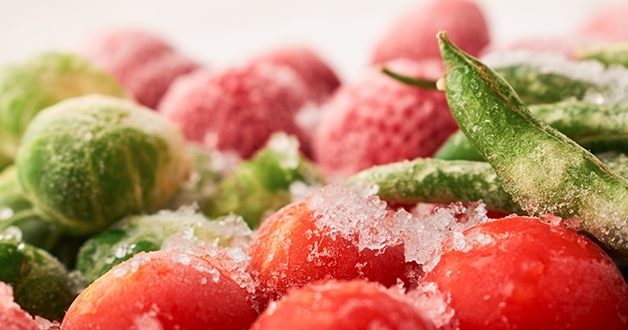
Frozen foods
0
1657
Do we have to be present in our menu?
An increasing proportion of the working population is beginning to take advantage of the "convenience" offered by hypermarkets, namely semi-manufactured and frozen foods. And that's no accident - getting home after a long and exhausting business day, very few working women would catch up to have a homemade dinner. But very few of them would think about the quality of frozen products and dishes.
There are various studies and guesses that struggle to "ensure" the presence of frozen foods on our menu. According to some studies, they are useful because the products are frozen almost immediately before they have lost their beneficial substances. While much of the fresh commercially available products travel for quite some time from the manufacturer to the end user.
According to some specialists ...
. freezing is one of the healthiest ways to store products. It allows conserving much of the beneficial substances, unlike the curing processes where harmful additives such as salt or sugar are used.
In addition, the flavor and consistency of frozen products differ only slightly from those of fresh ones, as long as this does not apply to preserved products.
Today, deep-freezing cameras are becoming more and more popular and become a very good investment because they save a lot of time and money. But there is no product, even frozen, that can be kept forever. However, it is advisable to keep three basic rules for freezing to ensure healthy and complete food:
For freezing, you must choose quality and well-cleaned products because not enough fresh fruits and vegetables will not get better than the cold.
The speed at which the whole product is cooled down to -18 ° C or even lower temperature is important, but not a large amount of product should be frozen at a time. At these temperatures, chemical reactions and microbial growth stop and the products keep as fresh as they were at the time of freezing.
If we decide to freeze certain products by ourselves, it is important to begin the preparation or so-called blanching, which helps to preserve the quality of the vegetables. The blanching is done by placing the prepared products for freezing - cleaned and crushed - in boiling salted water and boiling 3-4 minutes (after the water has been boiled again).
This will stop the action of enzymes that would otherwise spoil the taste and taste of the vegetables.
Once taken out of the water to cool, the vegetables are poured quickly with cold water or placed in a separate vessel immersed in ice water. Only after they have completely cooled they are packed and frozen.
Experience shows that products stored at low temperatures are less likely to suffer from a decrease in quality and nutritional value than those processed by drying or preserving. However, on the other hand, frozen products and dishes can become a real danger to human health if certain requirements for their preparation and storage are not met.
Methods for freezing products
There are three main modern methods of freezing products: fast, shock and super fast.
Fast-frozen foods are those that have undergone a freezing process, also known as "fast freezing", whereby the maximum crystallization zone is passed as quickly as possible depending on the type of food, the temperature achieved after thermal stabilization in all parts of the food is not higher than -18 ° C and is kept constant. It is important to note that in the production of quick-frozen foods only fresh raw materials of good commercial quality are used.
The processes of preparation and quick freezing of food are carried out as quickly as possible, using the necessary instruments, which minimize the possibility of occurrence of a chemical, biochemical and microbiological changes in the food.
Shock freezing is performed in refrigerated tunnels made of polyurethane foam panels and is suitable for fish and fish products, meat, game, and vegetables. It turns out that freezing is one of the most promising methods to ensure the durability of both meat products and fruit and vegetables.
The faster it is, the less the food is damaged!
It is important to read the product labels
It is important because of what the frozen food contains and what is the number of calories in it.
read more
However, in some cases, even if the calories are normal, a portion of frozen dishes may be insufficient for a lunch or dinner. That is why many nutritionists recommend that frozen foods be supplemented with salad, vegetables of steam or fruit, thus increasing the intake of fiber, which helps to save the body faster without consuming excess calories.
Chilled or frozen foods
The purpose of cooling (as well as freezing) is to slow down chemical processes in products that run under the influence of microorganisms and enzymes. The growth of bacteria is terminated at temperatures between -5 and -8 ° C, and mold development at -9 and -11 ° C. In addition, low temperatures decrease enzyme activity but do not stop it.
The cooling process can only slow propagation processes but not prevent them. Which in turn shows that cooled foods have a relatively short shelf life - two to three days from the date of manufacture. In the freezing process, the temperature is usually -18 ° C or even lower at which the bacteria can not grow and hence the shelf life is significantly higher.
Always choose well-packaged food!
Food packaging is designed to protect them from contamination and the appearance of harmful micro-organisms. In addition, special technology packaging significantly reduces food losses. Of particular importance in freezing is the proper packaging of the products. If the packaging is damaged, access to air is unlimited, where the food is dehydrated and the fat is frozen.
Processes that inevitably lead to a change in taste and the formation of harmful substances. Packaging should be hermetically sealed, which helps to preserve vitamins and minerals. For this purpose, special pumps are available commercially for easy withdrawal of air.
There is no doubt that frozen food saves our time and can be quite delicious when cooked better. But on the other hand, we can never be sure about the quality and origin of the products.
That is why a portion of vegetables of steam with a well-baked chicken fillet at home would certainly be a better allergen than the frozen equivalent!.


